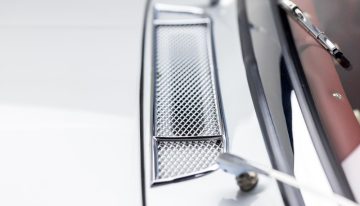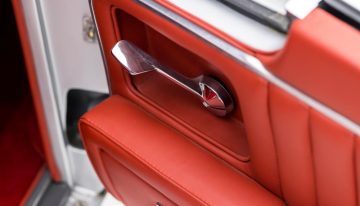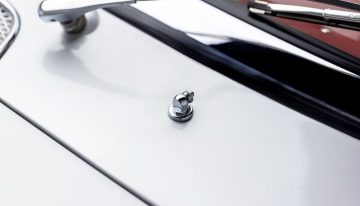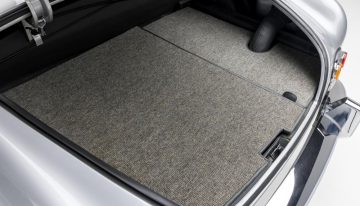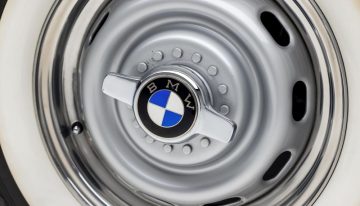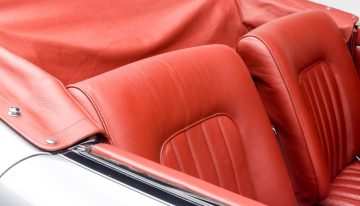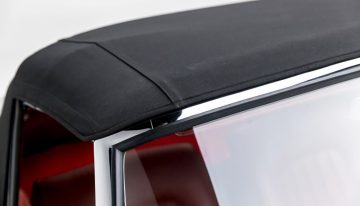The BMW 507 and Mercedes 300 SL are two iconic models whose history is linked to the name of Max Hoffman, the Austrian industrialist who imported numerous brands to the U.S. in the 1950s. While the Mercedes 300 SL was a great success, the BMW 507 was a great commercial failure. But the examples offered at auction sell for more expensive than the Mercedes 300 SL models. We try to explain why this happens.
Despite the commercial failure, the BMW 507 sells better at auction than the Mercedes 300 SL Roadster. Why? Usually, a 300 SL Roadster in good condition sells for between $1 and $1.2 million, and sometimes higher if it belonged to a celebrity. The price is about 200,000 less than the coupe. By contrast, the BMW 507 sells for prices over $2 million and even goes up to $2.5 million.
$2.1 to 2.4 million for a BMW 507 auctioned by Bonhams on January 27, 2023 in Scottsdale, Arizona
Bonhams Auction House is auctioning off a second-series BMW 507 on January 27, 2023, at an auction in Scottsdale, Arizona, U.S. It has chassis number 70110, being the 110th example of the 252 built. It was produced on January 14, 1958, and delivered with a factory hardtop.
After an inspection at BMW Classic in 2014, it was confirmed that the model retains the original chassis, suspension, brakes, engine, and gearbox and that the components changed to the engine and gearbox are original. As such, the car received 900 points out of 1000, being placed in Category 1, the highest possible. The model offered for sale is in excellent condition, is painted in Sillbergrau metallic silver color, and has red leather upholstery. The estimated sale price is between $2.1 and $2.4 million.
Prices above $2 million are normal
Another BMW 507 was offered at an online auction in May 2021 by Gooding & Company at an estimated price of $2.25 to $2.75 million (1.86 to 2.27 million euros). The model produced on August 27, 1957, and painted in the same silver-grey color sold for $2.2 million (1.81 million euros).
RM Sotheby’s auction house sold a 1958 BMW 507 at an auction held in early February 2020 at Retromobile in Paris for 1,996,250 euro. ($2,168,700). Another 1958 BMW 507 was sold by auction house RM Sotheby at an auction in Arizona for $2,175,000.
Although it was designed primarily for the U.S. market, only 34 examples were sold on the American continent. One of these examples, with chassis number 70134, believed to have belonged to a Hollywood producer, was sold at a Gooding &Company auction in March 2014 at Amelia Island for $1,815,000.
But the record price for a BMW 507 is held by a specimen that belonged to motorcycle and Formula 1 world champion John Surtees (1934-2017). He received the car as a gift from Count Domenico Agusta, head of MV Agusta, as a reward for Surtees’ first world motorcycling title in 1956. According to German auto motor und sport magazine, Surtees kept the car all his life, which was sold at auction after his death for a record amount of 4,702,795 euro.
The idea of BMW and Mercedes roadsters belongs to the same man
The BMW 507 and the Mercedes 300 SL have more in common than we might think. In both cases, it wasn’t the manufacturers who decided to produce these models but an Austrian industrialist named Max Hoffman. Hoffman imported different car brands to the U.S. in the 1950s, including Mercedes and BMW.
Mercedes had developed the W194 racing model for the 1952 season, the first after World War II. However, only ten units were produced based on a very light aluminum tubular chassis weighing 82 kg (181 pounds).
But production of a street version of the 300 SL was not planned. The idea came from Hoffman, who came up with the idea of producing a street version of the W194 at a meeting with Mercedes executives in 1953. The then-new Mercedes director, Fritz Konecke, agreed to Hoffman’s idea and ordered 1,000 cars. The 300 SL was unveiled in February 1954 at the New York Motor Show. Over 80% of the total production run of about 1,400 coupes was sold in the U.S., making it the first Mercedes model to be a significant success outside Germany.
In mid-1956, sales of the 300 SL Gullwing began to decline, and Mercedes decided to produce a roadster version with conventional doors. The Mercedes 300 SL Roadster was presented at the Geneva Motor Show in May 1957 and sold even better than the coupe: 1858 units.
With a weight of 1,500 kg (3,300 pounds) (the coupe) and 1,560 kg (3,440 pounds) (the roadster), the Mercedes 300 SL deserved the moniker S.L. (Super Leicht – Super Light). Unlike the W194, the 300 SL Gullwing had a tubular frame on a steel chassis with a steel body attached. The bonnet, doors, and boot lid were made of aluminum to achieve a low weight. There was also an all-aluminum body version that was 80 kg lighter. Only 29 examples were built with aluminum bodywork and these are much more expensive.
The Mercedes M198 3-liter inline six-cylinder engine was water-cooled and had two valves per cylinder. With Bosch mechanical direct petrol injection, the engine developed 215 ps (212 hp)/5,800 rpm and 275 Nm (203 lb-ft)/4,600 rpm. The 300 SL accelerated from 0 to 100 kph (62 mph) in 10 seconds and reached a top speed of 260 kph (161.5 mph), making it the fastest production car of its time. (roadster 0-100 kph (62 mph) in 10.0 s, top speed 250 kph (155 mph)).
The Mercedes 300 SL coupe costs 29,000 DM in Germany and $6,820 in the U.S. The roadster was priced at 32,500 DM in Germany and $10,950 in the U.S. Thus, the roadster was 10% more expensive than the coupe in Germany but 70% more expensive in the U.S.
Hoffman had made a business plan for the BMW 507 to sell in the U.S. for $5,000.
And the BMW 507? Hoffman thought his insight into the Mercedes 300 SL would work for BMW, too. So after the 300 SL’s launch, Hoffman proposed to BMW management that they produce a roadster to fill the niche between the Mercedes 300 SL and the cheaper, less capable Triumph and M.G. The Austrian industrialist’s business plan called for BMW to sell the car for $5,000. At the time, Mercedes only sold the 300 SL coupe for $6,820.
The initial design was realized by Ernst Loof, but Hoffman was not happy with the result and insisted that BMW hire Albrecht von Goertz, an independent industrial designer who did the final design, while Fritz Fiedler and Alex von Falkenhausen designed the mechanical part.
The BMW 507 is not heavy, weighing only 1,330 kg, 230 kg less than the Mercedes 300 SL Roadster. It is based on a shortened 503 chassis in which the wheelbase has been shortened from 2,835 mm (111.6 in) to 2,480 mm (98 in). BMW used more aluminum to achieve the reduced weight, and almost all the bodywork was made from aluminum.
But the 507’s problem was the engine. With a displacement of 3,168 cc (193.3 cu in), the V8 OHV engine codenamed 507/1 didn’t benefit from gasoline direct injection but from a pair of Zenith 32 NDIX two-barrel carburetors that gave it 152 ps (150 hp)/5,000 rpm.
With 63 ps (62 hp) less power than the 300 SL, the BMW 507 reached a top speed of only 200 kph (125 mph), 50 kph (31 mph) slower than the 300 SL Roadster, and acceleration from 0 to 100 kph (62 mph) was achieved in 11 seconds, 1 second slower than the 300 SL Roadster.
But the biggest problem was the price. BMW couldn’t match Hoffman’s proposed price. The BMW 507 cost 26,500 DM in Germany and $9,000 in the U.S., later increasing in price in the U.S. to $10,500. But at almost the same money, $10,950, the Mercedes 300 SL Roadster was on sale.
Because of this, the BMW 507 was a massive commercial failure. Production began in December 1956, and BMW only managed to sell 252 examples, losing money on every car sold. The failure of the 507 led to a massive loss of 15 million D.M. in 1959, the Bavarian firm was close to bankruptcy, and only Herbert Quandt’s capital injection saved BMW from being acquired by Mercedes itself.
Hoffman was well-intentioned but BMW missed the target price
There are reports that BMW was upset that Hoffman, who came up with the idea for the car, didn’t want to order it anymore, and the Bavarians withdrew his import license. Hoffman was well-intentioned, however, as convertibles were very popular in the U.S. at the time, accounting for 20% of the market.
When Hoffman suggested Mercedes produce a street convertible version of the 300 SL, Mercedes made a coupe. That’s why Hoffman turned to BMW.
Another reason was performance. The BMW 507 wasn’t a technological showcase like the Mercedes 300 SL: the aluminum V8 powered by twin carburetors developed only 152 ps (150 hp) and less torque than the Mercedes 300 SL’s direct injection engine.
And surprisingly, the BMW 507 was designed more for comfort than the sporty 300 SL, the exact opposite of the philosophy of the two marques today.
The conclusion is a paradox. If BMW had managed to produce the BMW 507 at a popular price, Hoffman would have ordered the 5,000 examples, and the roadster wouldn’t be such a rare car. And under those circumstances, indeed, auction prices would have been much lower. But that’s how the BMW 507 retained its exclusivity, and you can get one only if you pay more than $2 million.


